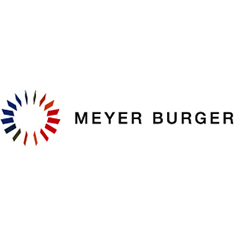- Difficult market environment in the first half of 2013
- Substantial cost reduction measures implemented
- Solid balance sheet structure with sufficient liquidity and high equity ratio
Meyer Burger Technology Ltd (SIX Swiss Exchange: MBTN) achieved net sales of CHF 90.4 million in a difficult market environment in the solar industry during the first half of 2013. The optimisation and consolidation programmes initiated in 2012 were fully implemented as planned by mid-year 2013. As a result of these cost reduction measures, operating expenses declined by CHF 54.7 million compared to the first half of 2012. EBITDA for the first half of 2013 amounted to CHF -58.6 million and the net result came to CHF -81.9 million. The balance sheet structure is very solid with an equity ratio of 59.8%. Meyer Burger also has a sufficient liquidity base. Cash and cash equivalents amounted to CHF 224.5 million as of 30 June 2013 and together with committed credit lines, Meyer Burger has over CHF 280 million in liquidity at its disposal.
Market environment
The market situation in the solar industry remained difficult during the first half of 2013 and, as expected, Meyer Burger Group’s results for this reporting period were impacted by relatively low customer demand for new product systems and equipment.
With the solar market continuing to consolidate, further ineffective production capacities at solar cell and module producers have been removed, which in turn is leading to a reduction of current overcapacities. There were indications during the first half of 2013 that prices for solar cells and modules were starting to stabilise following a period of strong price declines over the past two years. This is good news for producers who are still in the market and will be an important factor for investment decisions about expansion or new projects.
The global demand and growth of installed PV capacity at private and commercial end-users continues to be robust. Meyer Burger expects the market dynamics to help restore the supply-demand balance for cells and modules over the coming 6-12 months. Various long-term government programmes to promote renewable energies in, for example, Arab countries, India, China, the USA, South America or South Africa will also stimulate growth and lead to a broader global market base.
Meyer Burger expects customers to make new investments in wafer, cell and module manufacturing lines during the second half of 2013 and in 2014, resulting in an increase of its incoming orders and sales. Project transactions have risen considerably and Meyer Burger has achieved incoming orders of over CHF 40 million just in the past six weeks since 1 July 2013 (compared to CHF 82.5 million for the first six months of 2013). These contracts mark an important turning point in customer behaviour. They confirm Meyer Burger’s view, which was already published at the beginning of 2012, that the market will gradually recover and demand for production equipment will increase again from 2013 onwards.
Incoming orders
The volume in new orders amounted to CHF 82.5 million in the first half of 2013 (H1 2012: CHF 128.4 million) and thereby was at a similar level to the incoming orders in the second half of 2012 (H2 2012: CHF 95.0 million). First indications that a recovery in incoming orders is taking place have been observed in July/August of this year, as explained above.
Sales
Net sales were CHF 90.4 million (H1 2012: CHF 307.8 million). Meyer Burger had forecasted substantially lower net sales in comparison to the previous year for the full fiscal year as well as for the first half-year period 2013, at the time of the capital increase. It also indicated that up to three quarters of the expected net sales for the entire year 2013 will become effective during the second half of 2013, due to the project nature of the business and the recognition of sales in accordance with the Completed Contract Method. Meyer Burger again achieved sales in non-PV industries such as sapphire which is used in the production of high precision optic systems (LEDs) in the watch industry, or in microelectronics. However, the total amount of sales achieved during the first half of 2013 was slightly below the company’s expectations.



























